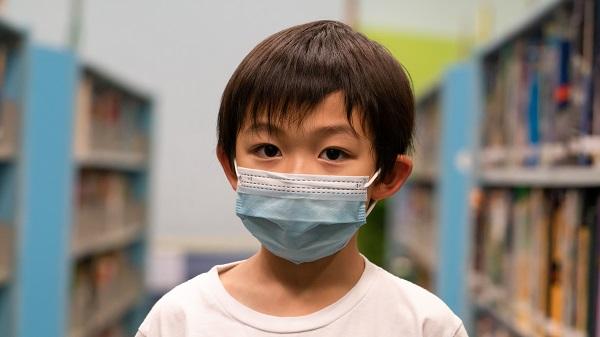Korean Kawasaki Cases Dropped Sharply Amid COVID-19 Controls
Nonpharmaceutical interventions such as masks and social distancing were likely what helped, offering clues on etiology.

In the early months of the COVID-19 pandemic, clinicians and immunologists were flummoxed by signs that SARS-CoV-2 appeared to produce a late, systemic inflammatory condition in children that shared several features with Kawasaki disease. Now, in an unexpected corollary, researchers in Korea say that the incidence of true Kawasaki disease has dropped markedly during this same period, likely due to the nonpharmaceutical interventions (NPIs) put in place to stop the spread of COVID-19.
The causes or triggers of Kawasaki disease have long eluded investigators. The disease—which elicits an acute vasculitis, predominantly of the coronary arteries in infants and children—is typically considered to be noncontagious, but genetic, viral, bacterial, immunologic, and environmental factors, both alone or in combination, have all been named as suspects. Now, the sharp dip in cases seen in Korea, due to measures intended to control a viral outbreak, have offered some unintended insights, say investigators led by Ji-Man Kang, MD (Severance Children’s Hospital, Seoul), and Young-Eun Kim, PhD (National Health Insurance Service, Wonju).
“Our findings provide important clues in the search for the etiologic agent of Kawasaki disease, suggesting [it] is triggered by infectious agents in genetically predisposed individuals,” senior author Jong Gyun Ahn, MD (Severance Children’s Hospital), told TCTMD in an email.
The findings were published today as a research letter in Circulation.
Kawasaki, Again
Ahn and colleagues compared Kawasaki disease case counts during February to September, when NPI measures were most strictly in place, with rates for the same months averaged over the preceding 10 years. During this pre-NPI window, the incidence was 31.5/100,000. But Kawasaki diagnoses “declined sharply” after NPIs were introduced, investigators reported, then plateaued after April, yielding an overall rate of 18.8/100,000: just 60% of that seen in previous years. Kawasaki disease is usually seasonal, spiking modestly in the late spring and summer, then more markedly in the winter, the authors note. Yet “this seasonal pattern was absent in the NPI period” of 2020.
Children under age 5, who are most affected by this illness, also experienced a marked drop in cases, which fell from 123/100,000 in the comparator period to 80/100,000.
“Our study provides apparent evidence that active interventions such as NPIs resulted in a reduction in Kawasaki disease,” Ahn said. “This reduction could be associated with a decrease in respiratory infections by NPIs. However, the impact of other environmental factors—other than infection—on Kawasaki disease—require continued assessment.”
Nevertheless, Ahn continued, the incidence of Kawasaki disease in Korea was anywhere from three to 16 times higher than that seen in Western countries, even after NPIs were implemented. “This suggests that certain other factors, including genetic predisposition, are still crucial in the etiology of Kawasaki disease,” Ahn said.
Also of note: other studies have hinted that a range of respiratory viral infections, such as those caused by an adenovirus, rhinovirus, enterovirus, or a different coronavirus, might be triggering factors.. “However, due to the seasonality of the viruses themselves, it was difficult to distinguish whether a concurrent infection or a preceding infection was the triggering factor,” Ahn noted. “In the case of multisystem inflammatory syndrome in children (MIS–C), which has similar clinical features to Kawasaki disease, recent studies have reported an increase in the number of MIS–C cases 4–6 weeks after peak COVID–19 activity. With this in mind, we are investigating whether any infectious diseases were prevalent before the Kawasaki epidemic.”
The results of follow-up studies, he said, “are expected to be available soon.”
Distinct Diseases, Important Clues
Commenting on the paper for TCTMD, Jane Newburger, MD, MPH (Harvard Medical School, Boston, MA), drew a distinct line between the MIS-C seen in young people as a result of a prior SARS-CoV-2 infection and Kawasaki disease, stressing that COVID-19 itself does not lower the incidence of the latter. “Rather, the measures taken to prevent COVID-19 transmission, like wearing masks, physical distancing, postponing of school reopening, and restriction on group activities, also cut down on transmission of viruses and infectious agents other than SARS-CoV-2 that may trigger Kawasaki disease,” she emphasized in an email. “Some have hypothesized environmental factors that are possibly not classic infectious agents as triggers, and exposure to these would also have been reduced by the precautions during the pandemic.”
What the drop documented by Kang et al suggests is a “proof of concept,” said Newburger, who co-authored the American Heart Association 2017 scientific statement on Kawasaki disease. What the study shows, she continued, is that “precautions to reduce exposure to infections and environmental factors actually lowered the incidence of Kawasaki disease.”
It’s “unlikely” that the kinds of measures taken to prevent the spread of COVID-19 “as a public health emergency could easily be maintained long-term to prevent rare diseases” like Kawasaki, she acknowledged. But the insights from papers like this one, as well as anecdotal reports from US hospitals also seeing a decline in Kawasaki cases, may help shine a light on a disease that has perplexed physicians for decades.
What’s more, the breakneck pace at which investigators have gained insights into MIS-C during COVID-19 may ultimately also illuminate Kawasaki disease. “There are a great number of research studies funded by the [US National Institutes of Health] and other agencies focused on precisely that question,” Newburger said. “Basic and translational research on the fundamental immunologic mechanisms are very likely to elucidate how classic Kawasaki disease is similar to and different from MIS-C with Kawasaki-like features.”
Shelley Wood was the Editor-in-Chief of TCTMD and the Editorial Director at the Cardiovascular Research Foundation (CRF) from October 2015…
Read Full BioSources
Kang J-M, Kim Y-E, Huh K, et al. Reduction in Kawasaki disease after nonpharmaceutical interventions in the COVID-19 Era. A nationwide observational study in Korea. Circulation. 2021;Epub ahead of print.
Disclosures
- The authors and Newburger report having no relevant conflicts of interest.





Comments